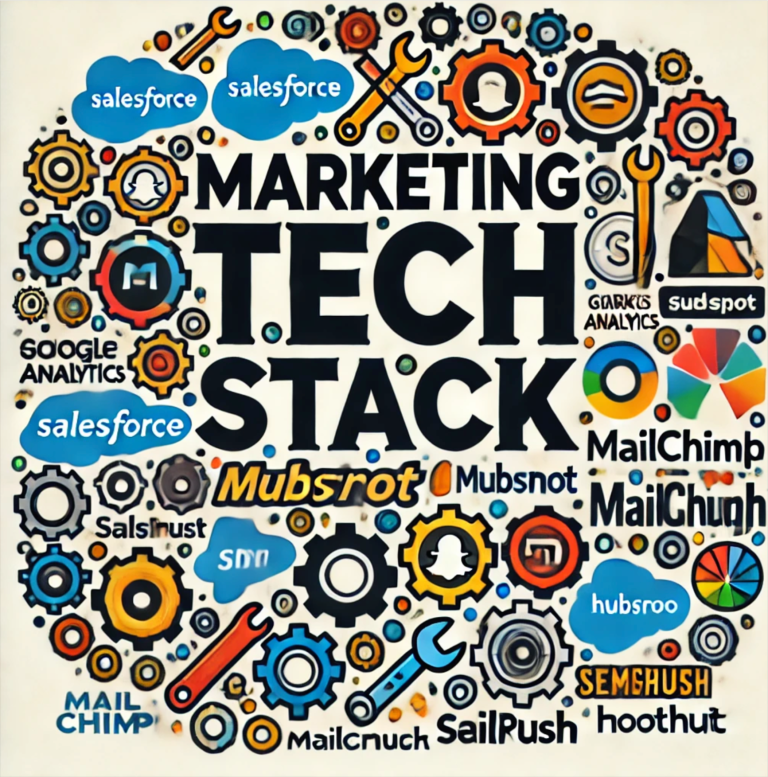Marketing Tech Stack
Basic stack of tools of modern marketer
Intro

Core Components of a Marketing Tech Stack
Customer Relationship Management (CRM) Tools
- Sales Cloud: This feature helps sales teams manage leads, track opportunities, and automate workflows. With real-time insights and customizable dashboards, sales teams can make data-driven decisions and close deals more efficiently.
- Service Cloud: Designed to enhance customer service, this tool provides a 360-degree view of customers, enabling support agents to deliver personalized and effective service. It includes case management, knowledge base, and omnichannel support.
- Marketing Cloud: This component allows marketers to create and manage personalized marketing campaigns across multiple channels, including email, social media, and mobile. With powerful analytics and segmentation tools, marketers can target the right audience and optimize their campaigns for better results.
- Commerce Cloud: Salesforce’s Commerce Cloud helps businesses create seamless and engaging e-commerce experiences. It supports various commerce models, including B2C and B2B, and integrates with other Salesforce products for a unified customer experience.
- Analytics Cloud: This feature provides advanced analytics and business intelligence capabilities. Users can create interactive dashboards, generate reports, and gain insights into customer behavior and business performance.
- Sales and Lead Management: Companies use Salesforce to streamline their sales processes, manage leads, and track performance. For example, a technology firm might use Salesforce to manage its sales pipeline, from lead generation to deal closure, ensuring no opportunities are missed.
- Customer Support: Businesses leverage Salesforce Service Cloud to provide exceptional customer service. For instance, a telecommunications company could use it to manage customer inquiries, resolve issues, and maintain high customer satisfaction.
- Marketing Campaigns: Marketers use Salesforce Marketing Cloud to execute targeted campaigns. A retail brand, for example, might use it to run personalized email marketing campaigns, track customer engagement, and measure campaign effectiveness
- Sales and Lead Management: Companies use Salesforce to streamline their sales processes, manage leads, and track performance. For example, a technology firm might use Salesforce to manage its sales pipeline, from lead generation to deal closure, ensuring no opportunities are missed.
- Customer Support: Businesses leverage Salesforce Service Cloud to provide exceptional customer service. For instance, a telecommunications company could use it to manage customer inquiries, resolve issues, and maintain high customer satisfaction.
- Marketing Campaigns: Marketers use Salesforce Marketing Cloud to execute targeted campaigns. A retail brand, for example, might use it to run personalized email marketing campaigns, track customer engagement, and measure campaign effectiveness.
Enjoying the ride and want to connect?
Get in touch with me using that red button and we can discuss what you have in mind!
Use this form to book a Call with me
Email Marketing Platforms

Popular email marketing platforms include Mailchimp, Constant Contact, and HubSpot. Mailchimp is known for its user-friendly interface and extensive automation features, making it a popular choice for small to medium-sized businesses. Constant Contact offers robust email list management and segmentation capabilities, as well as event marketing tools. HubSpot, on the other hand, integrates email marketing with its CRM, providing a seamless experience for managing customer relationships and email campaigns.
Content Management Systems (CMS)

Analytics and Data Visualization Tools

Integration and Automation Tools

Conclusion
Also Check Out Some of The Services That I Provide:
Audit
of your website, perfomance and brand campaigns, as well analysis of CJM and Funnel Management.
Consulting
Detailed recommendations based on analysis with handpicked tools and solutions.



